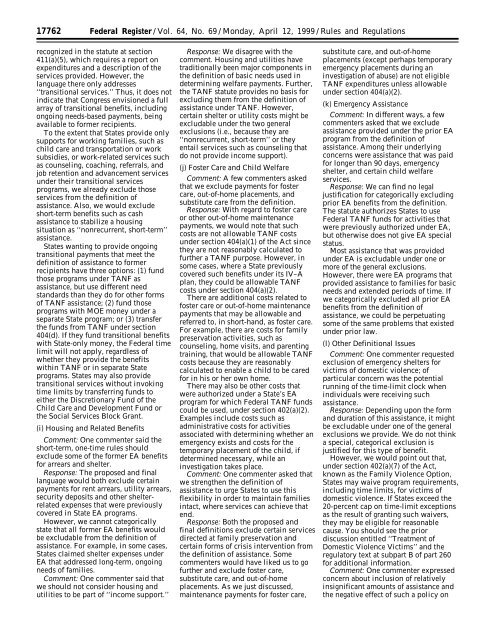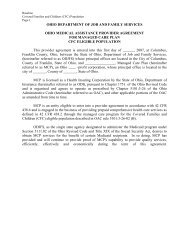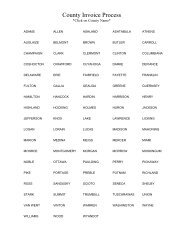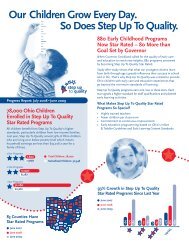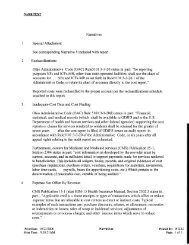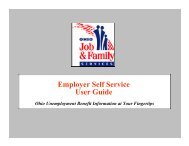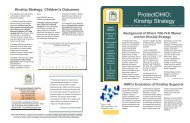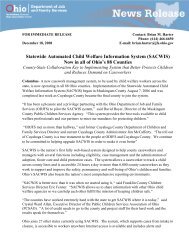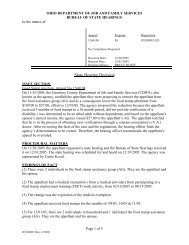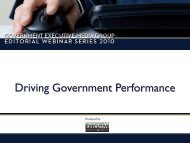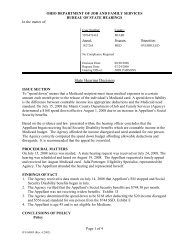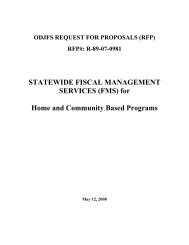Final TANF Rule as published in the Federal Register 4/12/1999
Final TANF Rule as published in the Federal Register 4/12/1999
Final TANF Rule as published in the Federal Register 4/12/1999
Create successful ePaper yourself
Turn your PDF publications into a flip-book with our unique Google optimized e-Paper software.
17762 <strong>Federal</strong> <strong>Register</strong> / Vol. 64, No. 69 / Monday, April <strong>12</strong>, <strong>1999</strong> / <strong>Rule</strong>s and Regulations<br />
recognized <strong>in</strong> <strong>the</strong> statute at section<br />
411(a)(5), which requires a report on<br />
expenditures and a description of <strong>the</strong><br />
services provided. However, <strong>the</strong><br />
language <strong>the</strong>re only addresses<br />
‘‘transitional services.’’ Thus, it does not<br />
<strong>in</strong>dicate that Congress envisioned a full<br />
array of transitional benefits, <strong>in</strong>clud<strong>in</strong>g<br />
ongo<strong>in</strong>g needs-b<strong>as</strong>ed payments, be<strong>in</strong>g<br />
available to former recipients.<br />
To <strong>the</strong> extent that States provide only<br />
supports for work<strong>in</strong>g families, such <strong>as</strong><br />
child care and transportation or work<br />
subsidies, or work-related services such<br />
<strong>as</strong> counsel<strong>in</strong>g, coach<strong>in</strong>g, referrals, and<br />
job retention and advancement services<br />
under <strong>the</strong>ir transitional services<br />
programs, we already exclude those<br />
services from <strong>the</strong> def<strong>in</strong>ition of<br />
<strong>as</strong>sistance. Also, we would exclude<br />
short-term benefits such <strong>as</strong> c<strong>as</strong>h<br />
<strong>as</strong>sistance to stabilize a hous<strong>in</strong>g<br />
situation <strong>as</strong> ‘‘nonrecurrent, short-term’’<br />
<strong>as</strong>sistance.<br />
States want<strong>in</strong>g to provide ongo<strong>in</strong>g<br />
transitional payments that meet <strong>the</strong><br />
def<strong>in</strong>ition of <strong>as</strong>sistance to former<br />
recipients have three options: (1) fund<br />
those programs under <strong>TANF</strong> <strong>as</strong><br />
<strong>as</strong>sistance, but use different need<br />
standards than <strong>the</strong>y do for o<strong>the</strong>r forms<br />
of <strong>TANF</strong> <strong>as</strong>sistance; (2) fund those<br />
programs with MOE money under a<br />
separate State program; or (3) transfer<br />
<strong>the</strong> funds from <strong>TANF</strong> under section<br />
404(d). If <strong>the</strong>y fund transitional benefits<br />
with State-only money, <strong>the</strong> <strong>Federal</strong> time<br />
limit will not apply, regardless of<br />
whe<strong>the</strong>r <strong>the</strong>y provide <strong>the</strong> benefits<br />
with<strong>in</strong> <strong>TANF</strong> or <strong>in</strong> separate State<br />
programs. States may also provide<br />
transitional services without <strong>in</strong>vok<strong>in</strong>g<br />
time limits by transferr<strong>in</strong>g funds to<br />
ei<strong>the</strong>r <strong>the</strong> Discretionary Fund of <strong>the</strong><br />
Child Care and Development Fund or<br />
<strong>the</strong> Social Services Block Grant.<br />
(i) Hous<strong>in</strong>g and Related Benefits<br />
Comment: One commenter said <strong>the</strong><br />
short-term, one-time rules should<br />
exclude some of <strong>the</strong> former EA benefits<br />
for arrears and shelter.<br />
Response: The proposed and f<strong>in</strong>al<br />
language would both exclude certa<strong>in</strong><br />
payments for rent arrears, utility arrears,<br />
security deposits and o<strong>the</strong>r shelterrelated<br />
expenses that were previously<br />
covered <strong>in</strong> State EA programs.<br />
However, we cannot categorically<br />
state that all former EA benefits would<br />
be excludable from <strong>the</strong> def<strong>in</strong>ition of<br />
<strong>as</strong>sistance. For example, <strong>in</strong> some c<strong>as</strong>es,<br />
States claimed shelter expenses under<br />
EA that addressed long-term, ongo<strong>in</strong>g<br />
needs of families.<br />
Comment: One commenter said that<br />
we should not consider hous<strong>in</strong>g and<br />
utilities to be part of ‘‘<strong>in</strong>come support.’’<br />
Response: We disagree with <strong>the</strong><br />
comment. Hous<strong>in</strong>g and utilities have<br />
traditionally been major components <strong>in</strong><br />
<strong>the</strong> def<strong>in</strong>ition of b<strong>as</strong>ic needs used <strong>in</strong><br />
determ<strong>in</strong><strong>in</strong>g welfare payments. Fur<strong>the</strong>r,<br />
<strong>the</strong> <strong>TANF</strong> statute provides no b<strong>as</strong>is for<br />
exclud<strong>in</strong>g <strong>the</strong>m from <strong>the</strong> def<strong>in</strong>ition of<br />
<strong>as</strong>sistance under <strong>TANF</strong>. However,<br />
certa<strong>in</strong> shelter or utility costs might be<br />
excludable under <strong>the</strong> two general<br />
exclusions (i.e., because <strong>the</strong>y are<br />
‘‘nonrecurrent, short-term’’ or <strong>the</strong>y<br />
entail services such <strong>as</strong> counsel<strong>in</strong>g that<br />
do not provide <strong>in</strong>come support).<br />
(j) Foster Care and Child Welfare<br />
Comment: A few commenters <strong>as</strong>ked<br />
that we exclude payments for foster<br />
care, out-of-home placements, and<br />
substitute care from <strong>the</strong> def<strong>in</strong>ition.<br />
Response: With regard to foster care<br />
or o<strong>the</strong>r out-of-home ma<strong>in</strong>tenance<br />
payments, we would note that such<br />
costs are not allowable <strong>TANF</strong> costs<br />
under section 404(a)(1) of <strong>the</strong> Act s<strong>in</strong>ce<br />
<strong>the</strong>y are not re<strong>as</strong>onably calculated to<br />
fur<strong>the</strong>r a <strong>TANF</strong> purpose. However, <strong>in</strong><br />
some c<strong>as</strong>es, where a State previously<br />
covered such benefits under its IV–A<br />
plan, <strong>the</strong>y could be allowable <strong>TANF</strong><br />
costs under section 404(a)(2).<br />
There are additional costs related to<br />
foster care or out-of-home ma<strong>in</strong>tenance<br />
payments that may be allowable and<br />
referred to, <strong>in</strong> short-hand, <strong>as</strong> foster care.<br />
For example, <strong>the</strong>re are costs for family<br />
preservation activities, such <strong>as</strong><br />
counsel<strong>in</strong>g, home visits, and parent<strong>in</strong>g<br />
tra<strong>in</strong><strong>in</strong>g, that would be allowable <strong>TANF</strong><br />
costs because <strong>the</strong>y are re<strong>as</strong>onably<br />
calculated to enable a child to be cared<br />
for <strong>in</strong> his or her own home.<br />
There may also be o<strong>the</strong>r costs that<br />
were authorized under a State’s EA<br />
program for which <strong>Federal</strong> <strong>TANF</strong> funds<br />
could be used, under section 402(a)(2).<br />
Examples <strong>in</strong>clude costs such <strong>as</strong><br />
adm<strong>in</strong>istrative costs for activities<br />
<strong>as</strong>sociated with determ<strong>in</strong><strong>in</strong>g whe<strong>the</strong>r an<br />
emergency exists and costs for <strong>the</strong><br />
temporary placement of <strong>the</strong> child, if<br />
determ<strong>in</strong>ed necessary, while an<br />
<strong>in</strong>vestigation takes place.<br />
Comment: One commenter <strong>as</strong>ked that<br />
we streng<strong>the</strong>n <strong>the</strong> def<strong>in</strong>ition of<br />
<strong>as</strong>sistance to urge States to use this<br />
flexibility <strong>in</strong> order to ma<strong>in</strong>ta<strong>in</strong> families<br />
<strong>in</strong>tact, where services can achieve that<br />
end.<br />
Response: Both <strong>the</strong> proposed and<br />
f<strong>in</strong>al def<strong>in</strong>itions exclude certa<strong>in</strong> services<br />
directed at family preservation and<br />
certa<strong>in</strong> forms of crisis <strong>in</strong>tervention from<br />
<strong>the</strong> def<strong>in</strong>ition of <strong>as</strong>sistance. Some<br />
commenters would have liked us to go<br />
fur<strong>the</strong>r and exclude foster care,<br />
substitute care, and out-of-home<br />
placements. As we just discussed,<br />
ma<strong>in</strong>tenance payments for foster care,<br />
substitute care, and out-of-home<br />
placements (except perhaps temporary<br />
emergency placements dur<strong>in</strong>g an<br />
<strong>in</strong>vestigation of abuse) are not eligible<br />
<strong>TANF</strong> expenditures unless allowable<br />
under section 404(a)(2).<br />
(k) Emergency Assistance<br />
Comment: In different ways, a few<br />
commenters <strong>as</strong>ked that we exclude<br />
<strong>as</strong>sistance provided under <strong>the</strong> prior EA<br />
program from <strong>the</strong> def<strong>in</strong>ition of<br />
<strong>as</strong>sistance. Among <strong>the</strong>ir underly<strong>in</strong>g<br />
concerns were <strong>as</strong>sistance that w<strong>as</strong> paid<br />
for longer than 90 days, emergency<br />
shelter, and certa<strong>in</strong> child welfare<br />
services.<br />
Response: We can f<strong>in</strong>d no legal<br />
justification for categorically exclud<strong>in</strong>g<br />
prior EA benefits from <strong>the</strong> def<strong>in</strong>ition.<br />
The statute authorizes States to use<br />
<strong>Federal</strong> <strong>TANF</strong> funds for activities that<br />
were previously authorized under EA,<br />
but o<strong>the</strong>rwise does not give EA special<br />
status.<br />
Most <strong>as</strong>sistance that w<strong>as</strong> provided<br />
under EA is excludable under one or<br />
more of <strong>the</strong> general exclusions.<br />
However, <strong>the</strong>re were EA programs that<br />
provided <strong>as</strong>sistance to families for b<strong>as</strong>ic<br />
needs and extended periods of time. If<br />
we categorically excluded all prior EA<br />
benefits from <strong>the</strong> def<strong>in</strong>ition of<br />
<strong>as</strong>sistance, we could be perpetuat<strong>in</strong>g<br />
some of <strong>the</strong> same problems that existed<br />
under prior law.<br />
(l) O<strong>the</strong>r Def<strong>in</strong>itional Issues<br />
Comment: One commenter requested<br />
exclusion of emergency shelters for<br />
victims of domestic violence; of<br />
particular concern w<strong>as</strong> <strong>the</strong> potential<br />
runn<strong>in</strong>g of <strong>the</strong> time-limit clock when<br />
<strong>in</strong>dividuals were receiv<strong>in</strong>g such<br />
<strong>as</strong>sistance.<br />
Response: Depend<strong>in</strong>g upon <strong>the</strong> form<br />
and duration of this <strong>as</strong>sistance, it might<br />
be excludable under one of <strong>the</strong> general<br />
exclusions we provide. We do not th<strong>in</strong>k<br />
a special, categorical exclusion is<br />
justified for this type of benefit.<br />
However, we would po<strong>in</strong>t out that,<br />
under section 402(a)(7) of <strong>the</strong> Act,<br />
known <strong>as</strong> <strong>the</strong> Family Violence Option,<br />
States may waive program requirements,<br />
<strong>in</strong>clud<strong>in</strong>g time limits, for victims of<br />
domestic violence. If States exceed <strong>the</strong><br />
20-percent cap on time-limit exceptions<br />
<strong>as</strong> <strong>the</strong> result of grant<strong>in</strong>g such waivers,<br />
<strong>the</strong>y may be eligible for re<strong>as</strong>onable<br />
cause. You should see <strong>the</strong> prior<br />
discussion entitled ‘‘Treatment of<br />
Domestic Violence Victims’’ and <strong>the</strong><br />
regulatory text at subpart B of part 260<br />
for additional <strong>in</strong>formation.<br />
Comment: One commenter expressed<br />
concern about <strong>in</strong>clusion of relatively<br />
<strong>in</strong>significant amounts of <strong>as</strong>sistance and<br />
<strong>the</strong> negative effect of such a policy on


